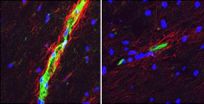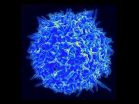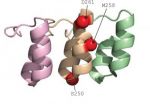(Press-News.org) PHILADELPHIA - Ancient philosophers looked to alchemy for clues to life everlasting. Today, researchers look to their yeast. These single-celled microbes have long served as model systems for the puzzle that is the aging process, and in this week's issue of Cell Metabolism, they fill in yet another piece.
The study, led by researchers at the University of Pennsylvania, identifies a new molecular circuit that controls longevity in yeast and more complex organisms and suggests a therapeutic intervention that could mimic the lifespan-enhancing effect of caloric restriction, no dietary restrictions necessary. After all, says senior author Shelley Berger, PhD, "who wants to live on 500 calories a day?"
Berger, a Penn Integrates Knowledge Professor in the departments of Genetics and Cell and Developmental Biology at the Perelman School of Medicine and the department of Biology in the School of Arts and Sciences, studies epigenetics, the science of the control of genetic information. Epigenetics comprises multiple regulatory layers, including chromatin packaging -- the orderly wrapping of DNA around histone proteins in the cell nucleus. By altering this DNA packaging, cells can control when and how genes are expressed.
"Aging is, in part, the accumulation of cellular stress," she explains. "If you can better respond to these stresses, this ameliorates the damage it can cause."
Berger and her team looked for chromatin-associated genes that could influence longevity by searching for genes that already were implicated in epigenetic regulation that might extend lifespan when deleted in the yeast, Saccharomyces cerevisiae. One such gene improved lifespan by about 25 percent – this would correspond to an increased lifespan in humans from 75 years to about 95 years – a substantial benefit to longevity, notes Berger. The research, conducted by postdoctoral fellow Weiwei Dang, PhD, aimed to unravel how this increase in longevity was achieved and if it was related to cellular stress.
First, the team asked whether the gene ISW2 is part of previously identified longevity pathways, especially those associated with caloric restriction, a well-known strategy for extending lifespan. But pathways involving a form of chromatin modification (histone acetylation) came up empty, as did an alternate pathway involving growth control, suggesting ISW2 functions through a never-before-seen mechanism.
The team then looked for answers in the function of the ISW2 protein, and found that its absence alters the expression of genes involved in protecting cells from such stresses as DNA damage. Deletion of ISW2 increases the expression and activity of genes in DNA-damage repair pathways – an effect also seen during calorie restriction.
The gene ISW2, it turns out, is involved in chromatin remodeling -- it controls the spacing and distribution of the histone "spools" around which DNA wraps. Normally, ISW2 dampens stress-response pathways, possibly because overactivation of these pathways is deleterious early in life, Berger speculates. Deletion or inactivation of the ISW2 gene activates those pathways, priming the cells to more effectively handle stress-associated genetic scars as cells age.
This effect is not limited to yeast. When Berger's team reduced the levels of a related gene in the nematode worm, Caenorhabditis elegans, they observed a 15 percent improvement in longevity, which is similar in magnitude to the lifespan extension observed in other worm longevity pathways. Similarly, knocking down expression of a human homolog in cultured human cells boosted the expression of stress-response genes that, again, like yeast, occur in DNA-damage repair pathways.
These findings suggest a pathway analogous to the one identified in yeast performs a similar function in humans, keeping stress-response genes in check – and if inhibited, could boost these pathways. But that has yet to be established. And, it is far from clear if tweaking these pathways can actually extend healthy human lifespan – but, of course, a goal worthy of further investigation, say the authors.
But, if there is a human version of the ISW2 pathway, these data suggest a possible therapeutic strategy for combating aging-related disorders in humans, Berger says. Calorie-restricted diets have been shown to extend lifespan in organisms from yeast to primates. But such diets are, well, difficult to "stomach."
Assuming these findings can be replicated and extended to humans, small-molecule inhibitors of the human form of ISW2 could potentially replicate that effect, leading to clinical benefits without dietary restrictions. More research must be done to work that out, however, note the researchers.
INFORMATION:
The study involved researchers at Penn, the Wistar Institute, the University of Washington, the Buck Institute for Research on Aging, and the University Medical Center Utrecht. Other Penn authors are Jean Dorsey, Gabriel Otte, Kajia Cao and Rocco Perry from the Department of Cell and Developmental Biology and Jennifer Wanat and F. Brad Johnson from the Department of Pathology and Laboratory Medicine.
The study was supported by the National Institutes of Health (P01AG031862) and the Ellison Medical Foundation.
Penn Medicine is one of the world's leading academic medical centers, dedicated to the related missions of medical education, biomedical research, and excellence in patient care. Penn Medicine consists of the Raymond and Ruth Perelman School of Medicine at the University of Pennsylvania (founded in 1765 as the nation's first medical school) and the University of Pennsylvania Health System, which together form a $4.3 billion enterprise.
The Perelman School of Medicine has been ranked among the top five medical schools in the United States for the past 17 years, according to U.S. News & World Report's survey of research-oriented medical schools. The School is consistently among the nation's top recipients of funding from the National Institutes of Health, with $392 million awarded in the 2013 fiscal year.
The University of Pennsylvania Health System's patient care facilities include: The Hospital of the University of Pennsylvania -- recognized as one of the nation's top "Honor Roll" hospitals by U.S. News & World Report; Penn Presbyterian Medical Center; Chester County Hospital; Penn Wissahickon Hospice; and Pennsylvania Hospital -- the nation's first hospital, founded in 1751. Additional affiliated inpatient care facilities and services throughout the Philadelphia region include Chestnut Hill Hospital and Good Shepherd Penn Partners, a partnership between Good Shepherd Rehabilitation Network and Penn Medicine.
Penn Medicine is committed to improving lives and health through a variety of community-based programs and activities. In fiscal year 2013, Penn Medicine provided $814 million to benefit our community.
Penn yeast study identifies novel longevity pathway
Findings inform relationship between cell stress response and aging
2014-05-08
ELSE PRESS RELEASES FROM THIS DATE:
Study helps explain why MS is more common in women
2014-05-08
A newly identified difference between the brains of women and men with multiple sclerosis (MS) may help explain why so many more women than men get the disease, researchers at Washington University School of Medicine in St. Louis report.
In recent years, the diagnosis of MS has increased more rapidly among women, who get the disorder nearly four times more than men. The reasons are unclear, but the new study is the first to associate a sex difference in the brain with MS.
The findings appear May 8 in The Journal of Clinical Investigation.
Studying mice and people, ...
Immune cells found to fuel colon cancer stem cells
2014-05-08
ANN ARBOR, Mich. — A subset of immune cells directly target colon cancers, rather than the immune system, giving the cells the aggressive properties of cancer stem cells.
So finds a new study that is an international collaboration among researchers from the United States, China and Poland.
"If you want to control cancer stem cells through new therapies, then you need to understand what controls the cancer stem cells," says senior study author Weiping Zou, M.D., Ph.D., Charles B. de Nancrede Professor of surgery, immunology and biology at the University of Michigan Medical ...
What doesn't kill you may make you live longer
2014-05-08
What is the secret to aging more slowly and living longer? Not antioxidants, apparently.
Many people believe that free radicals, the sometimes-toxic molecules produced by our bodies as we process oxygen, are the culprit behind aging. Yet a number of studies in recent years have produced evidence that the opposite may be true.
Now, researchers at McGill University have taken this finding a step further by showing how free radicals promote longevity in an experimental model organism, the roundworm C. elegans. Surprisingly, the team discovered that free radicals – also ...
Population genomics study provides insights into how polar bears adapt to the Arctic
2014-05-08
May 8, 2014, Shenzhen, China – In a paper published in the May 8 issue of the journal Cell as the cover story, researches from BGI, University of California, University of Copenhagen and other institutes presented the first polar bear genome and their new findings about how polar bear successfully adapted to life in the high Arctic environment, and its demographic history throughout the history of its adaptation.
Polar bears are at the top of the food chain, and spend most of their lifetimes on the sea ice largely within the Arctic Circle. They were well known to the ...
How immune cells use steroids
2014-05-08
Hinxton, 8 May 2014 – Researchers at the European Bioinformatics Institute (EMBL-EBI) and the Wellcome Trust Sanger Institute have discovered that some immune cells turn themselves off by producing a steroid. The findings, published in Cell Reports, have implications for the study of cancers, autoimmune diseases and parasitic infections.
If you've ever used a steroid, for example cortisone cream on eczema, you'll have seen first-hand how efficient steroids are at suppressing the immune response. Normally, when your body senses that immune cells have finished their job, ...
Just keep your promises: Going above and beyond does not pay off
2014-05-08
May 8, 2014 - If you are sending Mother's Day flowers to your mom this weekend, chances are you opted for guaranteed delivery: the promise that they will arrive by a certain time. Should the flowers not arrive in time, you will likely feel betrayed by the sender for breaking their promise. But if they arrive earlier, you likely will be no happier than if they arrive on time, according to new research. The new work suggests that we place such a high premium on keeping a promise that exceeding it confers little or no additional benefit.
Whether we make them with a person ...
Universal neuromuscular training an inexpensive, effective way to reduce
2014-05-08
ROSEMENT, Ill.─As participation in high-demand sports such as basketball and soccer has increased over the past decade, so has the number of anterior cruciate ligament (ACL) injuries in teens and young adults. In a study appearing today in the Journal of Bone and Joint Surgery (JBJS) (a research summary was presented at the 2014 Annual Meeting of the American Academy of Orthopaedic Surgeons in March), researchers found that universal neuromuscular training for high school and college-age athletes—which focuses on the optimal way to bend, jump, land and pivot the knee—is ...
Collaboration between psychologists and physicians important to improving primary health care
2014-05-08
WASHINGTON - Primary care teams that include both psychologists and physicians would help address known barriers to improved primary health care, including missed diagnoses, a lack of attention to behavioral factors and limited patient access to needed care, according to health care experts writing in a special issue of American Psychologist, the flagship journal of the American Psychological Association.
"At the heart of the new primary care team is a partnership between a primary care clinician and a psychologist or other mental health professional. The team works together ...
Small mutation changes brain freeze to hot foot
2014-05-08
DURHAM, N.C. -- Ice cream lovers and hot tea drinkers with sensitive teeth could one day have a reason to celebrate a new finding from Duke University researchers. The scientists have found a very small change in a single protein that turns a cold-sensitive receptor into one that senses heat.
Understanding sensation and pain at this level could lead to more specific pain relievers that wouldn't affect the central nervous system, likely producing less severe side effects than existing medications, said Jörg Grandl, Ph.D., an assistant professor of neurobiology in Duke's ...
Statins given early decrease progression of kidney disease
2014-05-08
AURORA, Colo. (May 8, 2014) - Results from a study by University of Colorado School of Medicine researchers show that pravastatin, a medicine widely used for treatment of high cholesterol, also slows down the growth of kidney cysts in children and young adults with autosomal dominant polycystic kidney disease (ADPKD).
ADPKD is the most common potentially lethal hereditary kidney disease, affecting at least 1 in 1000 people. ADPKD is characterized by progressive kidney enlargement due to cyst growth, which results in loss of kidney function over time. At one time, ADPKD ...
LAST 30 PRESS RELEASES:
Making lighter work of calculating fluid and heat flow
Normalizing blood sugar can halve heart attack risk
Lowering blood sugar cuts heart attack risk in people with prediabetes
Study links genetic variants to risk of blinding eye disease in premature infants
Non-opioid ‘pain sponge’ therapy halts cartilage degeneration and relieves chronic pain
AI can pick up cultural values by mimicking how kids learn
China’s ecological redlines offer fast track to 30 x 30 global conservation goal
Invisible indoor threats: emerging household contaminants and their growing risks to human health
Adding antibody treatment to chemo boosts outcomes for children with rare cancer
Germline pathogenic variants among women without a history of breast cancer
Tanning beds triple melanoma risk, potentially causing broad DNA damage
Unique bond identified as key to viral infection speed
Indoor tanning makes youthful skin much older on a genetic level
Mouse model sheds new light on the causes and potential solutions to human GI problems linked to muscular dystrophy
The Journal of Nuclear Medicine ahead-of-print tip sheet: December 12, 2025
Smarter tools for peering into the microscopic world
Applications open for funding to conduct research in the Kinsey Institute archives
Global measure underestimates the severity of food insecurity
Child survivors of critical illness are missing out on timely follow up care
Risk-based vs annual breast cancer screening / the WISDOM randomized clinical trial
University of Toronto launches Electric Vehicle Innovation Ontario to accelerate advanced EV technologies and build Canada’s innovation advantage
Early relapse predicts poor outcomes in aggressive blood cancer
American College of Lifestyle Medicine applauds two CMS models aligned with lifestyle medicine practice and reimbursement
Clinical trial finds cannabis use not a barrier to quitting nicotine vaping
Supplemental nutrition assistance program policies and food insecurity
Switching immune cells to “night mode” could limit damage after a heart attack, study suggests
URI-based Global RIghts Project report spotlights continued troubling trends in worldwide inhumane treatment
Neutrophils are less aggressive at night, explaining why nighttime heart attacks cause less damage than daytime events
Menopausal hormone therapy may not pose breast cancer risk for women with BRCA mutations
Mobile health tool may improve quality of life for adolescent and young adult breast cancer survivors
[Press-News.org] Penn yeast study identifies novel longevity pathwayFindings inform relationship between cell stress response and aging



